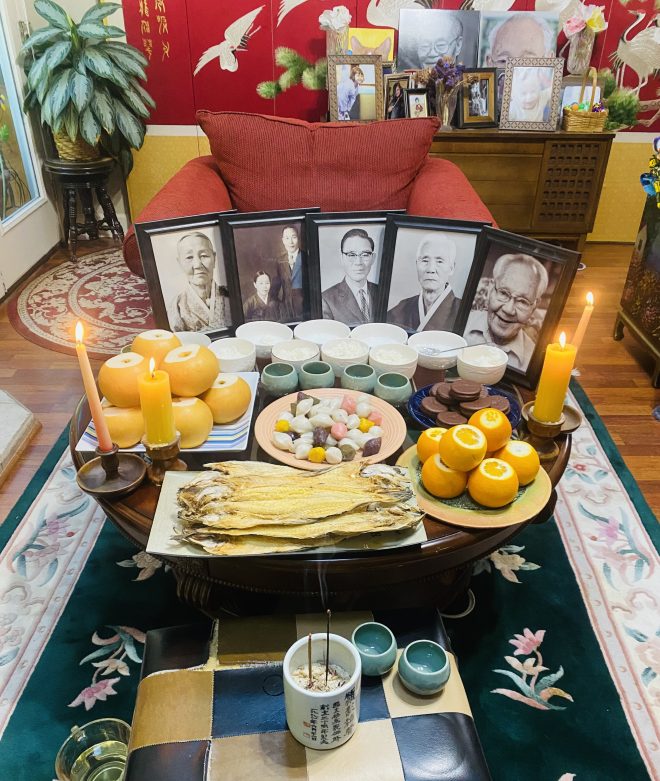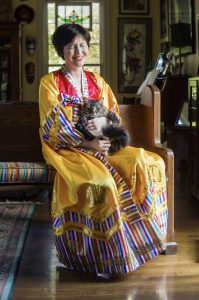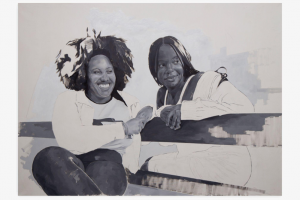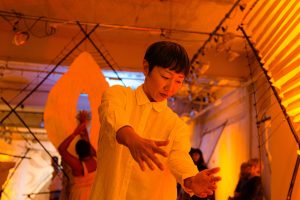Chuseok in the Heartland: A Korean American Family’s Tribute to Tradition


Chuseok—the most famous traditional holiday in South Korea—is a major mid-autumn harvest festival celebrated on the 15th day of the 8th month of the lunar calendar on the full moon. It takes place over three days in South Korea and one day in North Korea. Chuseok celebrates the year’s harvest and the year to come, crediting success to the blessings of ancestors. Two major traditions associated with Chuseok are Charye–a ceremonial honoring of ancestors at home–and Seongmyo, a visit to ancestors’ graves, often cleaning up the sites and bringing them their favorite foods as an offering. The remainder of the day is spent with family.
Korean American Nora B., aka Little Rock musician Princeaus, described Chuseok as “Korean Thanksgiving.” However, the practices differ from the American holiday in many ways. Nora’s grandfather grew up in a brutal Japanese occupation and subsequently survived the Korean War. After completing medical school in a bullet-riddled building, he seized the opportunity to immigrate to Canada. When he arrived in North America, he did not bring much. Still, he held tight to traditions and the practice of ancestor worship that plays a part in Korean culture. After marrying a British-Canadian woman, the family continued many traditional practices, including Chuseok. Nora said that although their grandmother could not speak Korean, she had learned to cook Korean food to help connect her children with their heritage.
Like many Indigenous cultures in North America, Koreans also have burial mounds. However, the threat to these traditions by development is significant. Nora’s family had to sell their ancestral burial mounds and cremate the remains. The ashes remained on the Korean peninsula, but the headstones were shipped to Arkansas, where they are now arranged on Nora’s aunt’s farm outside of Little Rock. This is where the family holds their Chuseok celebration, a testament to their determination to preserve their heritage.
Moving the headstones was a significant and stressful event. Nora said, “[The tombstones] are very significant, and we need to do our parts with them, making a new, sacred place for them. Because we’ve been blessed so much by our ancestors, wherever we bless our ancestors, that’s where they reside, there with us.”
On the day of their family’s Chuseok celebration, Nora’s family dresses in hanbok—brightly colored traditional Korean clothing worn on holidays and formal occasions—and makes the trip to their aunt’s farm. They set up an altar with photos of ancestors going back four generations and leave them offerings of food and drink such as rice, rice cakes, kimchi, Korean pears, dried fish, Korean rice wine and sometimes Moonpies.
The ceremony begins with the lighting of incense and a series of bows. They pour rice wine and wave it over the incense before placing it in front of each photo on the altar. Later, they pour the rice wine on their ancestors’ tombstones so they can drink, too. This process is repeated by each generation of the family, starting from elders to married descendants to their children. Nora, along with their cousins and siblings, are referred to as “the next generation.” They go last because it’s their job to respect their elders by going last and to understand that they must carry on these traditions. Without the next generation, these ancient traditions will die.
Nora said, “We cannot ever let that happen and must be our ancestors’ wildest dreams. No matter where our family immigrates, no matter what country our ancestral tombstones are in, we will always be Korean, and their history will always be ours as well. By feasting with our ancestors, we are giving thanks to all that they have done and reminding ourselves where we came from. It’s an honor to carry on these ancient traditions.
“The way I see death in terms of ancestor worship is whenever you die, you pass into the ancestral realm. You don’t pass away. You’re not gone. That’s a big part of Korean ancestor worship. For us, Chuseok symbolizes that love never dies.”
This article appears in our Fall 2024 Holidays Issue about the creative ways we celebrate holidays. You can read it online here.





Comments